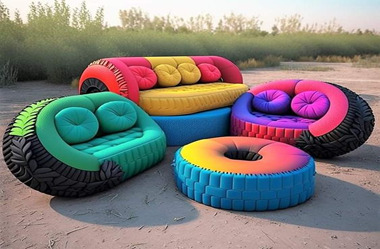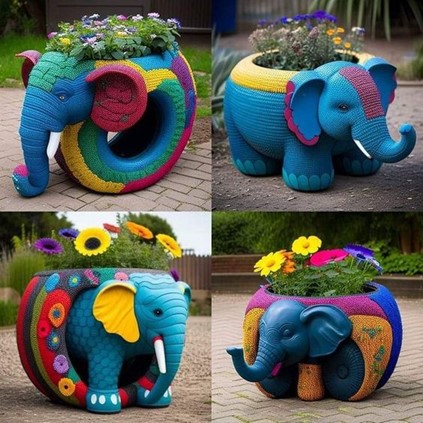The Case of Weary Tyres into A Modern Sofa and Flowerpots.
Most often towns or cities are full of heaps of dirt at almost each crossroads. These waste refuse full of nasty odours are cumbersome as they affect the health of the neighbouring hood as a result produces serious illness. As a popular saying goes as this people perish lack of knowledge, seems to be truth owing to the limited means available for wastage recycling. Therefore, in order to level up, upgrade our environment or surrounding, one just need an idea to revolutionize his environment.
An idea which is intangible unless express into a tangible form and asset, cannot enjoy protection under intellectual property law. Wastage recycling undergoes thoroughly, meticulous sorting starting from the waste collection and gathering, passing through the sophisticated machines which cut down and separate the useless elements and just store the useful ones which will undergo transformation process to attain the final end product. One can ask himself to know what an idea is all about. In simple words, an idea is the product of one’s imagination. An idea is a thought that is emanating or produced from one’s mind. Still not mature, an idea is ambiguous, unclear and unconstrued until the holder of such an idea defines it by laying down on a tangible format (books, CDs, USB Key and even through electronically means goes the same way). Let us assume a young woman whose imagination puts forth to revolutionize the transport sector by reducing traffic congestion. Therefore, the young woman will proceed by penning down all the elements that come from her mind pertaining the said project, construct them thoroughly. The latter entails in an arrangement of the elements properly, cross-checking of necessary elements by getting rid of unnecessary elements which when put together gives birth to an original creation.
Before defining what, an industrial design is all about, we need to understand what an original creation is all about under the intellectual property prism. Undoubtedly, the human mind is a laboratory by excellence whose ability and capacity are to craft on a tangible format works of the mind. An object realized by a Cameroonian differs from another object that is designed by a Sudanese. As a craftsman or designer, he pours out his soul into his artistic work which in turn carries his imprint. Through cutting, fitting the materials together, refining the object to obtain a final brand product. Thus, creating a work entails to bring into existence what has not existed before.
Any arrangement of lines or colors shall be considered a design, and any three-dimensional shape, whether or not associated with lines or colors, shall be considered a model, provided that the said arrangement or shape gives a special appearance to an industrial or craft product and may serve as a pattern for the manufacture of such a product[1]. The characteristics or features which are carried on a creation makes it unique from other existing creations[2]. That is, the creator of an applied art wholeheartedly for the creation of the said work, therefore his creation reflects his soul as the author. The creation bears the imprint of its author. Thus, the sum of his imagination, the expression of his imagination yielding into a special alignment of lines, colours with the esthetical aspects applied on an object serves as a pattern to manufacture a unique piece depicting the originality of the work. It gives an attractive appearance to the object which captivates the sight of potential consumers.
Wastage recycling of weary tyres into a modern sofa constitutes an original creation of industrial design.
 Copyright Pinterest[3]
Copyright Pinterest[3]
The Tri-dimensional aspect of the sofa above gives a particular shape to the said object. Observing it closely, the object is presented in a semi-circle form. The bi-dimensional aspect on the other hand, displays the colors of the sofas. With the irregular pattern of the lines that are inscribed on the sofas makes it unique on its own. Starting from the left till right, the sofas are painted with eye catching colors which renders the said sofas appealing to our sight. The aesthetic of the sofas gives to the sofas an outward special appearance. Therefore, the tri-dimensional aspect, the bi-dimensional aspects or both work for the good of the creator of an artistic work because the association of these two depicts originality of the work. Henceforth, the work stands-out from other pre-existing works. Unlike an invention which provides a solution over a problem[4], a work of an applied has as finality commercial end.
 Copyright Pinterest[5]
Copyright Pinterest[5]
The elephant shape displayed on the above applied work of art is the tri-dimensional aspect of the said work. The physical appearance of the above work differs from other pre-existing works in the local market. The association of colors, lines and even patterns (the bi-dimensional aspect) on the flower port gives to it a unique aspect.
Whatever may be the form of its expression, a work in the artistic domain is conferred protection under copyright as it constitutes an original creation of the human intellect. To this effect, works of applied art are intellectual creations[6].
Ownership right[7]confers to the creator moral attributes as well as economic attributes. The latter confers to the creator the exclusive right to exploit his work and get financial return over any reproduction, distribution of his work. The former confers to the owner over the creation the right to claim authorship of his work, to use a pseudonym or remain anonymous, oppose himself to any distortion of his work. Only properly deposited designs, that is those who are indecent, immoral, and prohibited by legal provisions cannot be registered. A certificate of registration of the industrial design is delivered to the applicant who files in for registration[8]. Therefore, the first applicant is presumed to be the creator of the design. Upon this legal ground, the presumed creator can oppose himself to any counterfeiting of his work[9], claim priority over the design[10]. The certificate of registration of industrial design[11] is conferred jointly to the people who created the work[12]. In case the industrial design is performed in an employment contractual agreement or where it is not but the employee in the course of the creation uses means and techniques specific to the business, ownership right shall belong to the employee. As the creator the work, the employee is entitled to remuneration which shall be determined and fixed by the parties. Failure to agree, the remuneration shall be fixed by the domestic competent court[13].
Summing up, an industrial design is composed of either a tri-dimensional aspect or bi-dimensional aspect. Creating a work of an applied art is good but filing for registration for the industrial design before the industrial office works for the good of the creator.
Bibliography :
[1] Article 1 (1) of Annex IV of the Bangui Agreement Act of December 14th, 2015.
[2] Article 2 (1) of Law No. 2000/011 of December 19th, 2000, on Copyright and Neighbouring Rights.
[3]https://www.pinterest.com/pin/571886852696617849/visual-search/?x=16&y=16&w=414&h=364&cropSource=6
[4] Under the light of article 1 (1) Annex I of the Bangui Agreement Act of February 24th, 1999, which provides a clear definition of an invention, humanity is facing serious hardships which need to be dissipated completely. Thus, by doing so, one can identify and target a sector in the economy and decide to bring an adequate solution to the problems faced. For instance, covid-19
[5] https://www.pinterest.com/pin/1033505814473223036/
[6] Article 4 (1) (x) Bangui Agreement, Act of December 14th, 2015, and Article 2 (1) of the Berne Convention 1979.
[7] Pursuant article 19 of the Bangui Agreement, Act of December 14th, 2015, ownership right confers to the creator of the industrial design protection over his work for five years renewable twice upon payment of a renewal fee. Failure to comply to this, the creator shall forfeit his rights.
[8] Article 17 of the Bangui Agreement, Act of December 14th, 2015.
[9] Article 35 of the Bangui Agreement, Act of December 14th,2015.
[10] Article 9 of the Bangui Agreement, Act of December 14th, 2015.
[11] Article 17 of the Bangui Agreement, Act of December 14th, 2015.
[12] Article 4 (3) and Article 5 of the Bangui Agreement, Act of December 14th, 2015.
[13] Article 6 (a)& (b)of the Bangui Agreement, Act of December 14th, 2015.



